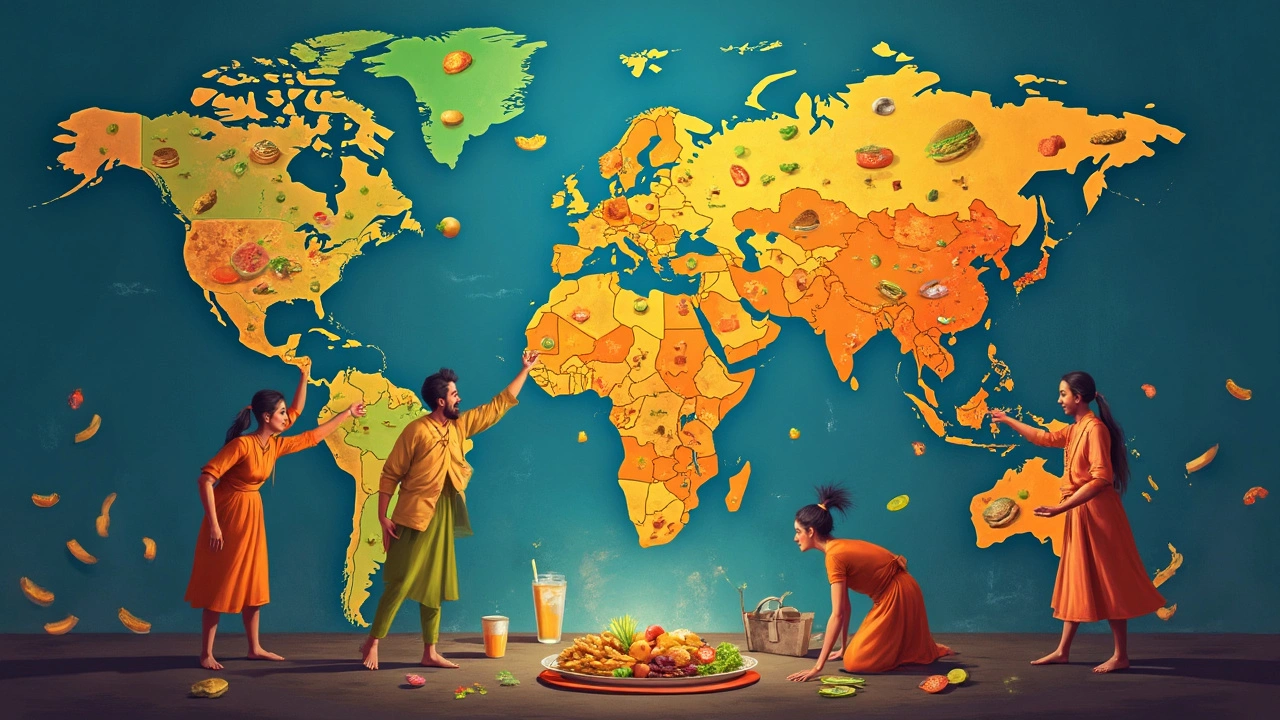Imagine a place where fries and sodas are more common at the dinner table than veggies or fruits. Some countries eat this way daily—no wonder their health stats raise eyebrows. Junk food has slipped into regular routines worldwide, but some spots are absolute champions at unhealthy eating. If you think your country’s got bad habits, wait till you see the data for the worst offender. Don’t be too quick to blame only fast food chains—it’s also about what lands in our shopping carts and what we snack on late at night. Get ready for some facts that might have you rethinking your next meal.
The Country With the Unhealthiest Diet: Shocking Leaderboard
Hands down, the United States often pops up at number one when it comes to unhealthy diets. And there’s no shortage of evidence to back that up. The Global Burden of Disease Study consistently ranks the US at—or near—the top for diet-related deaths. Around 36% of American adults are obese, according to the CDC’s 2023 report. That’s not all—roughly 10% of US kids already have fatty liver disease caused purely by what they eat. By the way, the average American eats about 92 grams of added sugar per day. That’s almost four times what the WHO recommends.
But wait, it’s not just the US. If you zoom out, the UK, Mexico, and several Middle Eastern nations show similar patterns. Kuwait, for example, has one of the world’s highest obesity rates; almost 40% of Kuwaiti adults are classified as obese. Australia and the UK are also in the running—both countries love their meat pies and sweet drinks. In a 2020 Lancet study, diets high in processed meat, fizzy drinks, and refined grains were worst in North America, followed by Central America and parts of the Middle East.
Curious about how countries stack up? Here’s a rundown of obesity and sugar statistics that really highlight the global picture:
| Country | Obesity Rate (%) | Average Daily Sugar Intake (g) | Main Unhealthy Foods |
|---|---|---|---|
| USA | 36.2 | 92 | Fast food, sugary drinks |
| Kuwait | 37.9 | 78 | Fast food, fried rice |
| Mexico | 32.4 | 81 | Soda, fried snacks |
| UK | 28.0 | 68 | Processed foods, sweets |
| Australia | 29.0 | 60 | Meat pies, soft drinks |
Western countries lead the unhealthiest diet lists partly because of how available—and cheap—junk food is. The term “food desert” is often thrown around, describing parts of the US and UK where it’s easier to find fast food than a fresh apple. Culture and advertising also play big roles, hooking people from an early age. No surprise, then, that health problems like diabetes and heart disease cluster here.
Why Do Some Countries Eat So Poorly?
It's not just about burgers and pizza. Unhealthy eating habits sprout from a complicated mix of lifestyle, advertising, government policies, and even local weather. Fast-paced jobs push people into grabbing quick, processed meals—cooking from scratch can feel like a luxury when you’re working late. In places like the US and UK, you can literally find fast food joints at every street corner. Temptation’s everywhere, from big superstores to highway rest stops.
It gets worse. Loads of food products are packed with sugar and fat, which our brains actually crave. This isn’t by accident; food companies spend billions engineering snacks that hit the ‘bliss point’—that sweet spot where you just want one more bite. Food advertising doesn’t help either. Kids see thousands of junk food ads every year, making sugary cereals and salty chips seem a normal part of breakfast and lunch.
Let’s talk pricing, too. Grocery staples like veggies and whole grains often cost more than ramen noodles or sugary snacks. Processed foods last longer on shelves and are easy to prepare, making them practical for busy folks. Even government subsidies are part of this web. In the US, subsidies favor big crops—like corn and soy—that fuel the production of cheap high-fructose corn syrup and vegetable oils used in junk food. That’s why a soda often costs less than a bottle of water.
Don’t forget climate and geography. In small, hot countries like Kuwait or the UAE, importing fresh produce jacks up prices. Restaurants and fast food become attractive options, especially when home cooking isn’t practical in sweltering summers. Poverty also pushes people toward calorie-dense food; it’s just more affordable to feed a family on fries and bread than on salads and grilled fish.
Technology’s hand is in the mix. Food delivery apps have made it way too easy to hit “order now” for burgers and shakes. Social media trends can turn even the worst nutritional fads into global phenomena in weeks. Who remembers putting whipped coffee or cheese tea on their Instagram feed?

Everyday Unhealthy Foods: What’s Actually To Blame?
People often blame one villain: the ever-present fast food burger. But the problem is way bigger. Let’s break it down—what kinds of foods are dragging down diets in these countries? Here’s what experts actually point to:
- Processed meats (sausages, hot dogs, deli slices)
- Sugary drinks (colas, energy drinks, sweetened teas)
- Refined grains (white bread, instant noodles, cookies)
- Trans fats (packed in biscuits, margarine, fried street foods)
- Excessive red meat and cheese
- Snack foods (chips, crackers, convenience bars)
- Sweets and desserts (pastries, ice cream, candy)
These foods crowd out healthy options. A salad or a bowl of oats is rarely as convenient—or as tasty—as a bag of cheese puffs. But the consequences aren’t pretty. The WHO says the world’s three leading diet killers are too much salt, too little fruit, and too few whole grains. The average American eats half the recommended fiber daily, and their sodium habits would make anyone’s blood pressure spike. In Kuwait, a typical breakfast might be shawarma or a croissant from a gas station—again, not super nutrient-rich.
It’s not all about what we eat—how much matters, too. “Supersize” culture in the US normalizes massive portions. Try ordering a small soda at a US cinema—you’ll get what would pass for a large almost anywhere else. It adds up.
Processed foods are designed to keep you hungry (ever notice how nobody eats just one chip?). Most major snack brands use formulas that balance fat, salt, and sugar to keep you coming back. That’s why healthier options feel less satisfying—they don’t hijack your taste buds in the same way.
Rethinking Food: Countries That Do It Right
If reading this has you worried about your fridge, check out how some countries get it right. Mediterranean countries, for example, thrive on plant-based diets. Greece, Italy, and Spain fill plates with vegetables, olive oil, nuts, fish, and a little bit of cheese or meat. Studies out of Harvard show Mediterranean eaters have about 30% less risk of heart disease. Japan is another superstar—they’ve nailed portion control and lean proteins. Ever seen a Japanese dinner plate? It’s half the size of what you’d find in London or Dallas, with lots more veggies and fermented foods.
You don’t need to move to Tokyo or Athens to steal their habits. Here are some tips that work anywhere:
- Fill half your plate with veggies—colorful ones really help.
- Swap out white bread and rice for whole grains (brown rice, quinoa, whole-wheat pasta).
- Try prepping meals ahead to resist the lure of fast food, especially on busy days.
- Keep healthy snacks handy—nuts, yogurt, fruit—so you aren’t running to the vending machine.
- Don’t fear fat, but stick to healthy types (olive oil or avocado instead of margarine).
- Watch your sugar—read labels, and swap soda for water or unsweetened tea.
- Eat slowly and stop before you’re stuffed, not when you’re bursting.
- Limit processed meat and cheese to once in a while—think of them as treats, not staples.
The healthiest countries also value meals as social time. Eating at a table with friends or family, with meals cooked from scratch, slows you down and helps you tune into what—not just how much—you’re eating. The secret isn’t a fancy superfood or a crash diet. It’s ordinary, real food shared with people you care about.

Changing Course: Can Unhealthy Nations Turn It Around?
Countries with the unhealthiest diets aren’t doomed. There’s proof habits can shift. In the 1970s, Finland had one of Europe’s highest heart disease rates. The government launched a national campaign—teaching cooking classes, slapping warning labels on junk foods, and promoting berries, bread, and fish. Forty years later, Finland’s diet is way healthier, and heart disease deaths have plummeted.
There’s more: In Mexico, soda taxes have cut sugary drink sales by about 8% since 2014. Chile has strict junk food labeling laws and even bans mascots like Tony the Tiger from cereal boxes. Even the unhealthiest diet nations can make dents with smart public policies.
But it’s not all top-down laws. Community gardens, cooking shows, and even viral TikTok chefs help nudge taste buds in a better direction. Kids in New York grow kale at school, while social media is packed with quick, healthy meal ideas that actually taste good.
Small changes add up. Swapping soda for water, taking the long way to work, cooking at home one extra night a week—it’s the little stuff that, over time, moves the needle. People can’t always control everything on their plates, but with a few tweaks, even countries at the top of the ‘unhealthy list’ can turn the tide.





